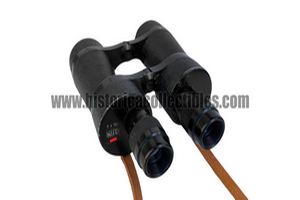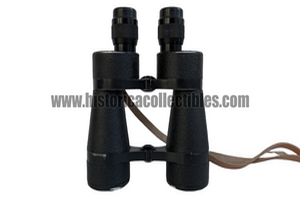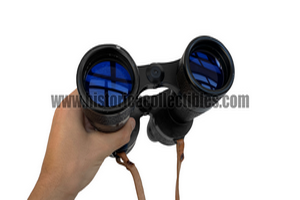Binoculars Nife 7x50 Porro II, Stockholm, Fully Coated, around 1948
7x50 binoculars equipped with Porro II Prisms, produced in Stockholm (Sweden) by NIFE or Nickel (Ni) and Iron (Fe), starting from 1948.
These binoculars are very similar to the military model produced by Srb & Stys Porro II 6.5x50, intended for the Kriegsmarine, in fact the first thing you notice is the absence of the central bar for the correct alignment of the two parts that make up the binoculars.
This is possible because NIFE binoculars have an interesting history that begins with Georg Vogel who in 1939 was an optical engineer and manager at the Czech optical company, Srb & Stys (now known as Meopta).
After the German occupation, Vogel, fearing possible persecution because he was a Jew, went to Sweden under the pretext of an order for optical instruments. Once there, assisted by a friend who was both Swedish consul in Prague and director of the Swedish company Jungner, which was the Swedish distributor of Srb & Stys products and a battery manufacturer, he managed to establish a subsidiary of Jungner called NIFE for the manufacture of optical products.
A feature that does not go unnoticed are the eyepieces positioned higher than the prism housing.
The lenses are equipped with a blue anti-reflective treatment that is still completely intact and functional.
All the mechanisms work correctly and the vision is clear and collimated.
History of NIFE:
Most people who have done military service in Sweden have come into contact with binoculars or other optical equipment manufactured by the company Nife. However, I don't think that many people know anything about the company's background and thought a brief history might be of interest.
The name Nife comes from the element designations Ni for nickel and Fe for iron and refers to their use as electrodes in batteries. Nowadays, almost only starter batteries with lead electrodes are used, but before World War II, nickel-iron batteries were also common. Apparently they also worked well, because I have heard the claim that the Russian tanks at Stalingrad, with such batteries, started at -40 degrees, but the German ones with lead batteries did not. Anyway, the company Svenska Accumulator AB Jungner successfully manufactured these batteries and had subsidiaries in many countries.
Like many other larger companies at the time, they also dealt with a lot of other things and had e.g. bought a fine mechanical workshop in Stockholm (Svenska AB Logg). How this company was then transformed into an optical industry is a strange story in which two young Czechs play the main role: Georg Vogl and Leon Kauders.
They both worked at Srb a Styrs in Prague, a well-known company at the time that manufactured binoculars and other optical products. Jungner had a subsidiary in Prague and also had the agency for Srb a Styrs in Sweden. They had, among other things, sold some binoculars to the Swedish defense that we collectors come across sometimes. When the Germans marched into Prague in March 1939, Georg Vogl contacted Gillis Rosborg, consul and head of the Jungnerbolaget in Prague. As Vogl and Kauders were Jews, they sought an escape from the persecutions of the Germans. Rosborg printed an order for 1000 binoculars 7x50. According to the settlement, the binoculars were to be delivered in parts and assembly was to take place in Stockholm. In this way, Vogl and Kauders received an exit permit to organize the assembly and were able to travel to Sweden.
When the two 26-year-old Czechs arrived in Stockholm, they started on their own initiative to negotiate with Jungnerbolaget about a license manufacturing of Srb a Sty's products in Sweden. The need for optical equipment for the Swedish defense was enormous, Sweden tried to quickly equip the defense that had been neglected during the 20s and 30s. Jungnerbolaget saw good profit opportunities and organized the production in the premises in Stockholm.
In his memoirs "On lenses and people" Georg Vogl describes his experiences during this hectic time. He tells, among other things, about how difficult it was to train workers for lens grinding, the core of the business, if you want to produce useful optics. Perhaps it is also interesting that Vogl refers to Sweden at this time as, "a technologically developing country". Something that we may have a hard time understanding today . By the way , if anyone wants to read a well-written and funny memoir written by an insider in the Swedish armor industry, I can warmly recommend Vogl 's book.
Now to the products. Nife's biggest customer was of course the Swedish defense. They made distance instruments, aiming instruments for ksp, grk and cannons, reflex sights for lv cannons and airplanes just to name a few products. I have a list of Nife's production for the defense. It includes 47 different instruments and I don't think it is complete. Vogl's first binocular construction in Sweden was an observation binocular for the air defense called OLA1 (1940). It is a large tripod binocular with roof edge prisms (difficult to sharpen). Magnification 8x with 50mm objective. The binoculars come with a storage box and a stand with cradle. I was surprised by the quality of the binoculars the first time I had the opportunity to try one. 303 pcs OLA 1 was followed by a second order OLA 2, 767 pcs (1944), a total of 1070 pcs.
I have already mentioned that the defense was in dire need of binoculars. They ordered e.g. year 1940 27750 single and double binoculars 6x30 from Nazi Germany (manufacturers Zeiss, Hensold, Busch and Spindler&Hoyer). These were part of a secret agreement where Sweden bought military equipment from Germany in 1940-1945 to the value of 218 million kroner, which in today's monetary value corresponds to 3.7 billion kroner. In addition to optical material, e.g. howitzers, machine guns, airplanes and all-terrain vehicles. Sweden paid for half with gold and free currencies and for the other half through barter with e.g. iron ore, paper and wood, the so-called clearing. An order for binoculars 6x30 also went to the Swedish companies Nife and AGA, a total of 7100 if I have interpreted the material at the War Archives correctly. For AGA's part, the delivery seems to have included 2500 double binoculars and these were probably the only binoculars this company has produced. Nife produced 3100 single and 1500 double binoculars on this order but subsequently produced more even after the war. The German binoculars and the first order from Nife and AGA are marked with the year 1942.
Nife has also manufactured binoculars 7x50 (possibly also as 10x50) in Porro II construction for the navy. The binoculars are identical to those found in Europe marked Srb & Stys and Vogl probably had the drawings with him when he came to Sweden. Porro II binoculars have a typical long slim and elegant appearance. They are very well balanced and pleasant to hold, but the real purpose of the design is to get a brighter image through fewer reflections on the light's path through the scope. Before antireflex treatment became common, this was given great importance. The manufacturing method was expensive and it was mainly used for military binoculars intended for marine use. Worthy of mention are the Porro II binoculars that Zeiss produced for the Kriegsmarine, especially the 8x60 models.
Nife produced a copy of the most famous of the Zeiss skis mentioned above, the so-called 8x60 Deck Mounted. In appearance, it is almost identical to the model, but in the lens construction they differ slightly. Georg Vogl had spent 3 years at Zeiss in Jena during his training and this explains his good knowledge of Zeiss designs. Most likely these binoculars were made after the war because Zeiss lost all patent rights in connection with the surrender of Germany. Probably a total of about a hundred were produced in two series, one in 1946-47 and one in 1951.
Even after the war, assignments from the defense continued to roll in. I have found the 7x50 Porro II I mentioned above with Swedish Navy markings and year 1947-49. The Home Guard is said to have ordered a 9x45 in the early 1950s. They have used a 6x30 binocular body and put on a larger lens to get increased brightness and magnification. I have never come across such binoculars so far.
During the late 1950s and early 1960s, the competition from, among others, West German Zeiss seems to have become overwhelming, because the defense's orders went abroad. At this time, the armed forces apparently still had plenty of money and could buy the best that was on the market. Zeiss Oberkochen 6x30B, 7x50BA and Swarovski 7x42 are examples of this. I don't have an exact year when Nife stopped producing binoculars but it seems to have been in the early 60's. An interesting detail as a conclusion. For the Swedish UN battalion in the Congo, Georg Vogl designed a very robust 6x30 binocular. The binoculars were rubber coated and the mounting of prisms was done from the front, through the objective opening, all to make it as tight as possible. A test series of 50 was produced and used in the Congo, but there was no further order. At the end of his professional career, Vogl was a consultant for West German Steiner and modern Steiner binoculars that can be bought today are strikingly similar to the 1963 Nife binoculars.
Although Nife no longer manufactured binoculars, it continued to produce optical instruments for the defense but also for the civilian market. This first took place in competition with the rival AGA, but as the international market hardened, the companies invested more and more in cooperation. In 1977, Nife, the name had been changed to Jungner Instruments AB in 1968, was bought by Bofors and the company was merged with AGA. The business was moved to AGA's premises on Lidingö. The companies that today manage the legacy of Nife and AGA are called FLIR Systems Optronics (which makes advanced night vision binoculars) and Saab Tech Electronics.”
Source: https://familjenhakansson.se/Annat/Kikare-Optik/Ki...



